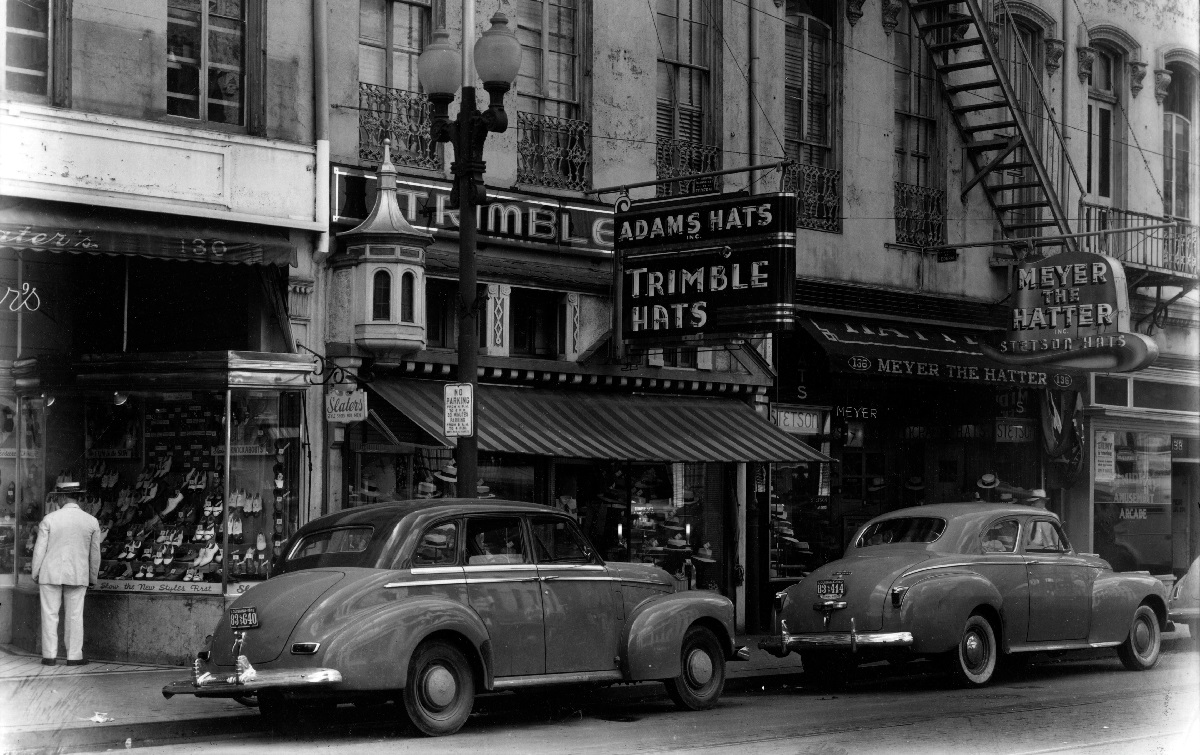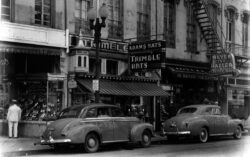Spring 2023
Put a Lid on It
Sartorial mainstay Meyer the Hatter
Published: February 28, 2023
Last Updated: June 1, 2023

Photo by Charles L. Franck, The Historic New Orleans Collection
Meyer the Hatter next to a bygone fellow hat shop, July 1942.
Born in New Orleans to German immigrant parents in 1863, the first Meyer the Hatter got his start as a delivery boy at John N. Adams in 1877, carrying hat boxes across the city. In 1885, Meyer went to work for H. D. McCown, a leading gentlemen’s clothier. He was managing the hat department within a few years, traveling to New York to buy wholesale and meeting with industry salesmen at home. In 1892, H. D. McCown was bought out by Mayer Israel, the nephew of Leon Godchaux of department store fame, to start his own eponymous gentlemen’s store. In 1894, Sam Meyer established a tiny one-room shop at 112 St. Charles that he called Meyer’s Hat Box. His first deal was with the salesman for Stetson, securing in-demand inventory of the “hat that won the West.” Within a few years, Meyer expanded up the block, moving to larger digs at 116 St. Charles. (The old Hat Box was soon absorbed by Rubensteins, an up-and-coming gentlemen’s store).
Perhaps the impetus for branching out on his own was the growing Meyer family. Sam Meyer married Charlotte “Lottie” Cook in 1890 and soon had six children. Their only son, Andrew Parker Meyer, began working in his father’s store as a teenager, taking on a leadership role in the store’s administration after service in the First World War. In the late 1930s, the Meyers—who were practicing Methodists—faced antisemitism from their landlord due to their name. They moved up the block from 116 to 136 St. Charles Avenue.
Through the first half of the twentieth century, hats were commonplace accessories for men, who might include in their wardrobe a summer straw hat, a winter felt hat, a special occasion hat, and a dependable every-day hat. In addition to the American Stetson brand, Meyer the Hatter was, and still is, home to Ecuadorian Panama straw hats, Italian Borsalinos, and Belgian Vimenet hats. Other American brands have filled the shelves, including Dobbs, Mallory, and Dunlap.
Samuel H. Meyer passed away at his summer home in Biloxi in 1947. At eighty-three, he had worked in the hat business for seventy years and operated his own hat store for fifty-three years. He had established relationships with the leading hat companies, generations of loyal customers, and a legacy of hatters bearing his name.
The third generation of hatters had joined the business before Meyer’s death. When Samuel Meyer III returned from service in World War II, his father, the hatter Andrew Meyer, invited him to come work in the store. “I thought you’d never ask!” Sam responded. Sam’s brother, William Meyer, worked alongside him for six decades.
The store made its last move in 1961 when the family bought 120 St. Charles—remaining on the same block as the original Meyer’s Hat Box. With three stories of hats for sale, the store assumed the title of the South’s Largest Hatter.
That same year, the story goes, President John F. Kennedy attended his inauguration without a hat. Kennedy’s youthful preference for bare-headedness has long been considered the death knell for the popularity of men’s hats. But the story is wrong. The truth is, JFK wore a silk top hat throughout his inaugural day, and men’s hats had already been declining in popularity for decades. As early as 1929, Meyer the Hatter’s advertising warned men who forewent hats of sinusitis and unattractiveness. The American hat industry formed the Hat Research Foundation in 1938 to lobby for a National Hat Week. But by the mid-twentieth century, men’s hats fell out of mainstream fashion. You can look at pictures of Mardi Gras crowds from the 1940s to the 1960s and watch the hats disappear.
The simplest explanation for the decline in hat wearing is that a once-utilitarian accessory was no longer necessary. Hats protect wearers from the sun, rain, wind, and dirt. The mid-twentieth century saw an uptick in car ownership among middle-class people—no need to walk to work, or take public transit—and those cars had an enclosed roof, with a low ceiling that didn’t accommodate hats well. The post-war housing boom increased the prevalence of standing showers, allowing for more regular bathing; hair no longer needed to be covered to keep it clean between weekly baths. New, longer hairstyles got mussed under cover. Sunglasses and sunscreens also became cheaper and more widely available after the war, providing sun protection without a brim.
Though hat styles have ebbed and flowed, Meyer the Hatter has endured; it is not only the South’s largest hatter but also the oldest continuously owned hat store in the country. The Meyer family has maintained their shop in the first block of St. Charles Avenue on the central thoroughfare of New Orleans shopping history for well over a century. Today, the shop still serves locals who have found their toppers there for generations, as well as tourists, celebrities, and the film industry. Though hats may no longer be a daily accessory for some, they’re an important element of style among the city’s many social aid and pleasure clubs for their Sunday second lines, and a large part of the shop’s Carnival season sales are driven by the events surrounding Zulu Social Aid and Pleasure Club’s parade on Mardi Gras day.
Longevity is habit for Meyer the Hatter. At ninety-eight years old, Sam Meyer III still works three days a week. His son Paul is the full-time owner and his grandsons Chris and Cedric manage daily operations. Visitors to the shop at 120 St. Charles walk past vintage display windows into a shop full of hat racks and towers of hat boxes. Inside, thanks to five generations of professional hatters, they will find berets, trilbies, Panamas, fedoras, flat brims, high-tops, bowlers, derbies, visors, ball caps, bucket hats, straw hats, silk hats, wool caps, and felt hats to fit their headwear needs.
Lydia Blackmore is the decorative arts curator at The Historic New Orleans Collection. She has curated exhibitions on decorative arts of the Gulf South, Mardi Gras, and shopping in New Orleans.
